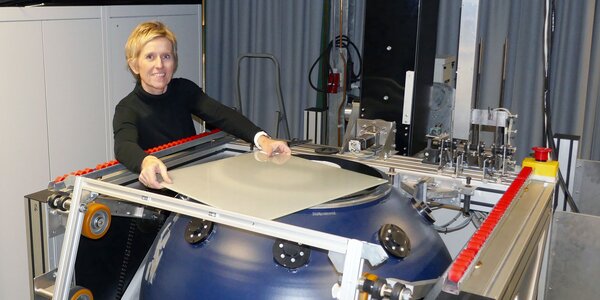The importance of reliable and independent measurements
Mardenkro is firmly committed to ensure that its products have a sound scientific basis and therefore maintains close contact with Wageningen University & Research, the perfect partner for conducting independent measurements and pursuing new avenues.
Measuring accurately is an art. Two measurements performed on the same material under the same conditions have to produce the same results. And if you want to compare materials, you need a measurement protocol in order to make any reliable claims. The LightLab at Wageningen University & Research specializes in this area.
Silke Hemming, head of Wageningen UR’s Greenhouse Technology research team: “We’re seeing that manufacturers of light-transmitting materials are developing their own measuring methods. These can be very sound and consistently reproducible. But the drawback is that the results can’t be compared with those of another manufacturer that uses its own measuring method. Comparison is only possible when a uniform measurement protocol exists. Another important factor is that an independent authority should carry out the measurements, and not the manufacturer itself. Independent uniform measurement protocols improve the quality of the entire horticultural sector.”
Condensation
Developed by Wageningen UR in consultation with growers, the new Dutch standard (NEN 2675) on light transmittance and scatter through greenhouse materials will come into effect in early 2018.
Since technology is continually evolving, measurement protocols and NEN standards become obsolete. And sometimes there is not even a protocol in place yet. “A good example is condensation on materials,” Hemming adds. “We’re currently devising a method for this. To introduce a new protocol, there has to be a need for one in the sector, and it has to be generally accepted as the standard.”
In some cases a standard does exist, but for another industry. One example is the standard for material aging. “There is a standard for this in the solar industry, but aging conditions are completely different in greenhouses, where humidity is high and chemicals are used.
Although the influence of UV radiation is comparable, the existing solar standard doesn’t go beyond the first three years – yet a greenhouse can last for at least 15 years. We are working with the TÜV Nederland technical inspection service on adapting the standard to make it suitable for the horticultural sector.”

Silke Hemming
AntiReflect
Mardenkro has many of its products analyzed at the LightLab in Wageningen. In the case of coatings, the measured values depend on the coating thickness, which is therefore standardized as much as possible. With new products, such as AntiReflect, for instance, treated window panes from greenhouses are also sent to the lab. The growers then receive a report on the results.
The LightLab is a world leader in reliable measurement of greenhouse materials. The number of properties the lab can measure is constantly growing: transmittance of light at different angles of incidence, the spectrum of the transmitted light, haze and scatter, emissivity and reflection, condensation, aging, and air permeability of materials (e.g. screen fabric).
Ray tracing
Besides measurements, Mardenkro also calls on Hemming’s research group for calculations. One example was an initial assessment of the effects of AntiReflect using the ray-tracing and Intkam computer models. “Field data is constantly fed into these models to further validate them,” Hemming explains. “Ray tracing, which follows the path of a beam of light as it travels through a material, is commonly used in our Winterlight greenhouse, for instance. First we did the calculations, then we built small scale models of the greenhouse, and finally the greenhouse itself. These calculations between the model and the actual measurements we make in the greenhouse appear to correspond.”
Wageningen UR is constantly seeking to optimize greenhouse materials and climate control. This leads to new types of greenhouses, which are gradually being adopted by the industry and actually compete with coatings. “In the future, growers will need to weigh up the cost of investing in an expensive greenhouse or optimizing their greenhouse climate with coatings instead,” Hemming points out. “The big advantage of coatings is that they are very flexible and can be used in existing greenhouses. This means that they have a bright future. The sustainability requirements for coatings are also likely to be tightened up at some point in the future, however.”
Smart materials
Mardenkro is a member of the Club of 100, a group of leading horticultural suppliers that co-finance and support the horticultural research carried out at Wageningen UR.
The group is involved in pre-competitive projects, one good example being Smart Materials for Greenhouses. Hemming again: “In partnership with Eindhoven University of Technology and companies like Mardenkro, we are researching materials that self-adapt to changing conditions. They might become darker or more diffuse in stronger sunlight, for instance.”
Her group also conducts business-to-business research for individual businesses. “The results are only shared with the client, of course. Even with this kind of research, we retain our independence. We adhere to the Netherlands Code of Conduct for Academic Practice, which upholds the principles of scrupulousness, verifiability, impartiality and independence. That, too, is in the interests of quality in the horticultural sector.”